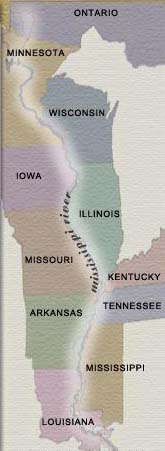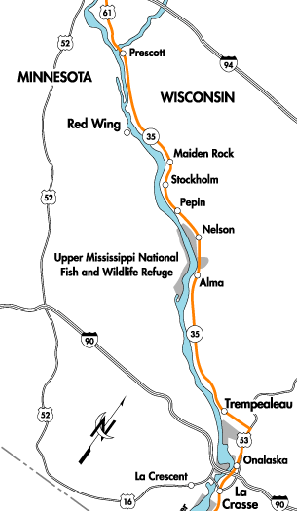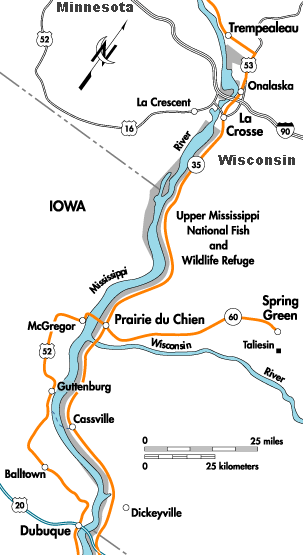- At 2,552 miles, the Mississippi River is the longest river in North America and the third longest in the world, and begins at 1,475 feet above sea level.
- The Mississippi River drains approximately 40% of the continental United States-all or part of 31 states, and two Canadian provinces, with a total drainage area of 1.25 million square miles.
- The Mississippi releases 2.3 million cubic feet of water per second into the Gulf of Mexico and more than 400-million cubic yards of mud, sand and gravel each year.
- The Mississippi River provides transport for more than 472-million tons of cargo each year, including 46% of the grain exported from the United States.
- The Mississippi is a major flyway for migratory birds. It is used by up to 40% of North America's duck, goose, swan and eagle population.
- A system of 29 locks and dams control navigation on the Upper Mississippi between Minneapolis, Minnesota and St. Louis, Missouri.

A general map of the river.
- A traveler can follow the Great River Road over 3,000 miles through the ten river states and the two Canadian provinces of Ontario and Manitoba.
- There are 87 federal parks and refuge areas; 1,100 significant National Historic Register sites; and more than 150 visitor centers and museums along the Great River Road
- The longest over water bridge in the world is the Lake Pontchartrain Causeway bridge in New Orleans. It crosses 24 miles of open water.
- All along the Mississippi, you are never more than 100 miles from a casino.
- The Mississippi River Parkway Planning Commission (MRPC) was legislatively appointed in 1938, but the road was not begun until 1954.
- The Levees of the lower Mississippi are
longer, and higher than the Great Wall of China.
 was taken at LaCrosse, and time
was spent at the Dresbach center near LaCrescent in Minnesota.
This was my first real acquaintance with the river, before this
we had given each other only the briefest acknowledgment. This
was on my first motorcycle trip out to Yellowstone Park, and though
I was anxious to get to the mountains, prairies, wildlife, and scenic
views of the West, as well as getting to feel a part of the history
of the region, I had to stay and introduce myself to the river. That
first stop lasted for a couple of hours, even though the weather
was not at it's best. I had a nice lunch, called home, sat by the
side of the river, and walked for a while. I also spent some time
watching the tow boats and barges. The picture here is the first one
that I ever took on this spot. It is notable for the fact that the river
is not actually visible in the shot (it was just to the right outside
of the photo). This was my second time across the Mississippi, but my
first at the crossing of Lacrosse. It was to be far from my last.
I have been back many times and plan to return
many more. There are the river cities, and the little river
towns, the celebrations, the scenic views, the wildlife, and the constant
ebb, and flow of the river, and of the people who live on it, works it's
length, visit, or are just passing through. The river area has a unique
combination of hectic activity, and laid back lifestyles, that make the
whole place a wonder.
was taken at LaCrosse, and time
was spent at the Dresbach center near LaCrescent in Minnesota.
This was my first real acquaintance with the river, before this
we had given each other only the briefest acknowledgment. This
was on my first motorcycle trip out to Yellowstone Park, and though
I was anxious to get to the mountains, prairies, wildlife, and scenic
views of the West, as well as getting to feel a part of the history
of the region, I had to stay and introduce myself to the river. That
first stop lasted for a couple of hours, even though the weather
was not at it's best. I had a nice lunch, called home, sat by the
side of the river, and walked for a while. I also spent some time
watching the tow boats and barges. The picture here is the first one
that I ever took on this spot. It is notable for the fact that the river
is not actually visible in the shot (it was just to the right outside
of the photo). This was my second time across the Mississippi, but my
first at the crossing of Lacrosse. It was to be far from my last.
I have been back many times and plan to return
many more. There are the river cities, and the little river
towns, the celebrations, the scenic views, the wildlife, and the constant
ebb, and flow of the river, and of the people who live on it, works it's
length, visit, or are just passing through. The river area has a unique
combination of hectic activity, and laid back lifestyles, that make the
whole place a wonder. 
